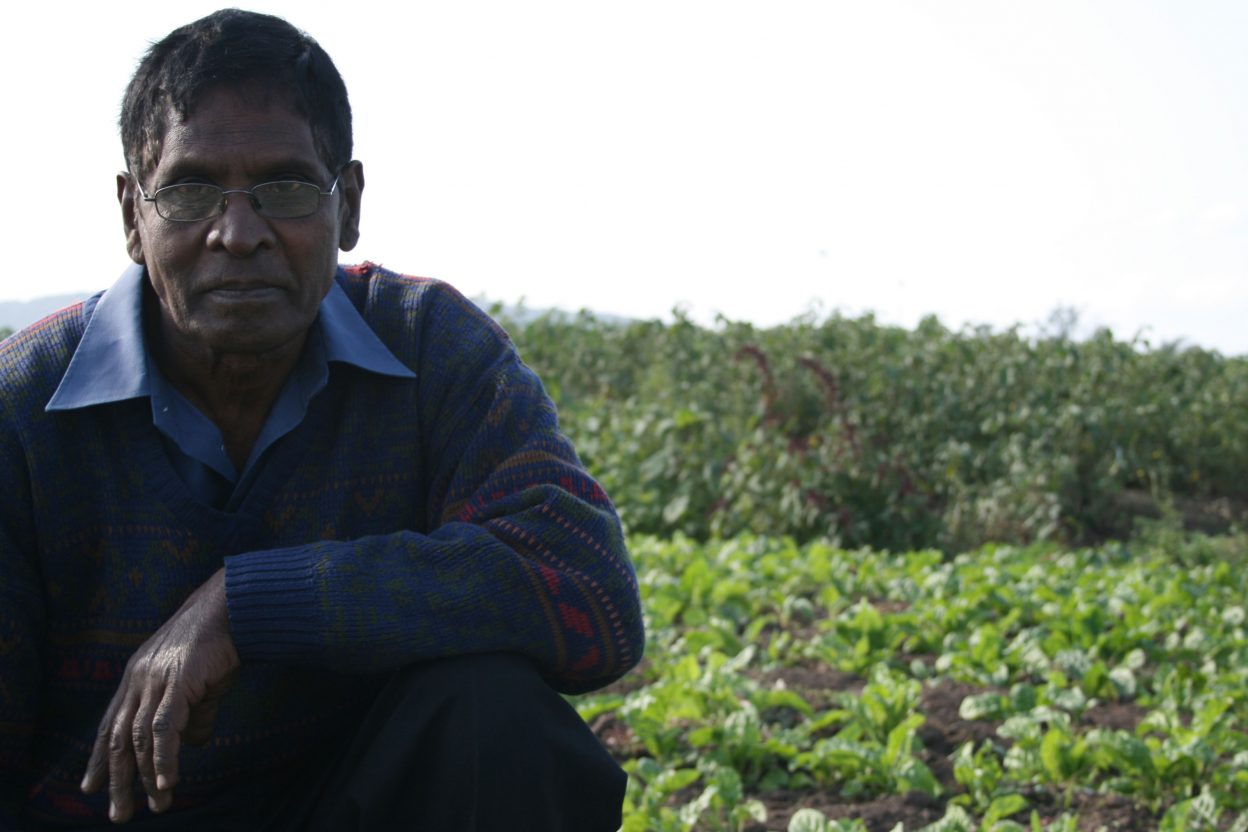Written by Megan Lewis, media and communications officer at groundWork/Friends of the Earth South Africa
“The land means the world to me in the sense that I’m here six days a week from 7 in the morning till 5 in the afternoon and when I get home it’s only my farm that I think of and nothing else. So it’s my livelihood and I would like to be on the land.”
This is Siga Govender’s last wish. Siga works on the fertile land found next to the old Durban airport in south Durban, KwaZulu Natal. He has worked in the area for thirty-six years and on this particular piece of 14 hectare ground for twenty-five of those. His grandparents arrived in the country from India as indentured labourers in the 19th century, and began farming shortly after their entry into South Africa, passing their love of farming on to their children and grandchildren. Together with his wife, Siga grows vegetables like spinach, cabbage, lettuce and beetroot, herbs like mint, thyme and coriander (or dhania, as it is known by the Indian community) and flowers such as marigolds. His son and daughters have always been involved on the farm, transporting the produce to the local morning markets in the city and surrounding areas, and working on the land to plant and harvest the crops. Although they are studying and pursuing other jobs at the moment, Siga sees his children taking over the land once he has grown too old to continue farming.
Siga and his family are part of a community of farmers on this land; they hold one of the sixteen farms. They are evidence that, despite the continuous onslaught of industrial expansion which makes south Durban a renowned pollution hotspot, there is life arising from the land and the people have continued to create a life for themselves. The basin is home not only to dirty industries but also to more than 200 000 people whom the farmers feed with their fresh, cheap produce. Like Siga, most of the farmers have had land in the wider south Durban area passed down to them from their forefathers and mothers who made the journey from India to South Africa as indentured labourers in the 1860s. In comparison, big industry arrived in the area more recently, beginning operations in 1930 and intensifying from the 1950s onward. There has always been farming in south Durban. Ironically, however, people of Indian origin were allowed to work the land here because, under British colonial rule, they could not get land north of the Umbilo River, closer to the city. This was only for ‘white’ people. The farmers were pushed from pillar to post during apartheid and finally, in the late 1980s, came to settle on the old airport land.
Whilst the farmers have been welcomed by the surrounding communities, residents have mostly been hostile to the degrading and dangerous actions of the big industries like Engen, Sapref and Mondi. For many, the farmers are part of the life-blood of the south Durban community as they support not only informal and local markets like the Bangladesh market, but their impact is also seen throughout broader Durban as they support chain supermarkets like Shoprite/Checkers and OK stores. The farmers are an important part of the wider Durban community. Siga explains their role in providing food security for the people:
“We supply food which is fresh, number one, and the other thing is it’s cheap in the sense that we are close to the markets. And if we don’t supply to the thousands of people that buy from us, they will actually be deprived of their daily food.”
Despite this, the displacement of the farmers has been an on-going threat. Siga was previously displaced from land that was also part of the old airport land but which was sold to Sasol Fibres and has subsequently been changed into a warehouse for Jet clothing company.
Kista Govender has been Siga’s farming neighbour on the airport land from the beginning. His parents were part of the group of farmers from Springfield in Durban who were moved to the airport land during the industrialisation of the area by the city and big business. And this can happen again at any time in the future due to the nature of the contracts that the farmers work under. These contracts were granted to them by the House of Delegates (the house of Indian representatives during the South African transition government) in the 1980s and were subsequently taken over by the Airports Company of South Africa (ACSA). The contracts state that the farmers can be given a thirty day eviction notice which will leave them without a place of work within a month. For Kista this means the loss of a sustainable life and stable income:
“I got used to working and so I can’t stay at home. I rely on the farm. If I don’t work here I can’t do another job. I’m not collecting an old age grant; I work for my living.”
Other plans for displacement were proposed by the city in conjunction with Toyota, Transnet and various other surrounding industries and businesses. As a result of this, the farmers set up the Airports Farmers Association (AFA) with Siga as their chairperson in order to fight for the farmers to maintain their right to a sustainable livelihood and to provide food security to the people of Durban. In 2005, when ACSA sent out development plans, the South Durban Community Environmental Alliance (SDCEA) joined AFA to keep the land for the purpose of farming rather than for the expansion of industry. They won this battle, but today they face a new one.
The proposal of a R1.8 billion dug-out port lead by ACSA and Transnet was confirmed this year in both President Zuma’s State of the Nation Address and the budget speech by the Minister of Finance, Pravin Gordon. The rumour has been concretised, and is being portrayed in the media as fact. It is through the media and communication by SDCEA with the government, ACSA and Transnet that the farmers have found out what the consequences of this new development could be for them. The farmers are yet to hear directly from either of the above parties; there is no line of communication between them even though this might have huge consequences for the lives of many people.
Savy (or Sally as she is known by the rest of the farmers) Govender has been farming with her husband since 1989, providing for her family, the labourers on her farm and the community. She speaks of ‘the one house, one garden’ strategy proposed by the KwaZulu Natal’s premier Zweli Mkhize in 2009, and how this is being contradicted by the construction of the dug-out port and the displacement of the farmers:
“I think they (the government and ACSA) are very unfair because if you hear on the TV every day the government wants everyone to do subsistence farming. They’re encouraging people to grow their own food. So we are actually growing for ourselves and for many more people that we are supplying to. Because how many people are actually doing farming these days? We would love to be here a long time, but the government is being unfair to us; to them we are nobody.”
The neo-liberal economic policy of the South African government has been heightened with the introduction of the macro-economic Growth, Employment And Redistribution (GEAR) Programme in 1996. The consequent promotion of privatisation, a decrease in trade and industrial regulations, and minimal state involvement in these sectors, have left the majority of the South African population unprotected from environmental and social injustice. In the case of the farmers, growth and development for the South African economy means the removal of their place of livelihood and, for the wider south Durban community, it means the extraction of a sustainable source of food.
This South African scenario is not very different to that found in various other countries around the world; elites found in the government, corporate and industrial world forget the needs of the citizens of the country in which they operate as they prioritise the lining of their pockets. The elite’s development model of increased wealth for a few determines the mass poverty of the majority. There is no other way to describe this except as perpetuating threatened food sovereignty of the people through a classic case of land grabbing.
The land is not simply soil and plants to the farmers, but is closely tied to their sense of heritage and cultural identity. Siga will continue to fight for his wish to become a reality and, with the rest of the farmers, will strive to maintain the life they desire:
“Here we are, sixteen farmers who are established and have for twenty-five years been farming in the area. Instead of assisting us, they want to get rid of us and get us off the land. I don’t know if that is on their mind, but if it is, then that is sad. I feel positive that we will stop them in the sense that we will get public support in the matter because it’s something that they need and something we supply on a daily basis. So we need the public to support us.”

